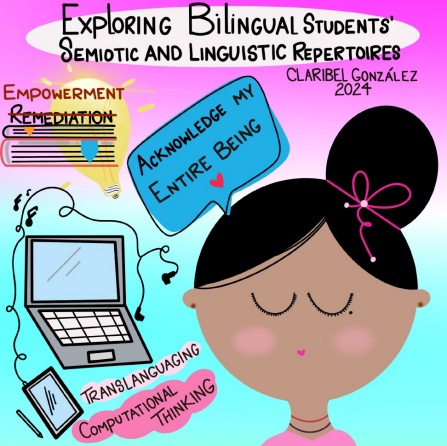Exploring Bilingual Students’ Linguistic and Semiotic Repertoires While Developing Computational Literacies in Dual Language Classrooms
BY CLARIBEL GONZÁLEZ
Dual language programs have witnessed significant growth across the United States, reflecting a commitment to bilingual education. These programs not only celebrate linguistic diversity, but also aim to enhance academic achievement in both languages. My name is Claribel González, and I am a doctoral student at the University at Buffalo. I am deeply intrigued by the potential of dual language classrooms. My research centers on understanding how students’ linguistic and semiotic repertoires intersect with the development of computational literacies.

Infographic created by Claribel González depicting Empowering Bilingual Minds: A Vision for Integrating Linguistic Fluidity and Computational Literacy in Education, 2024.
While dual language classrooms provide a rich context for language learning, they are not immune to challenges. Some classrooms fall short in fully embracing the dynamic and fluid linguistic practices of bilingual students. Instead of celebrating these diverse repertoires, bilingual students are framed as deficient, emphasizing remediation over empowerment. This deficit-oriented perspective can limit educational opportunities, including access to emerging fields like computer science.
I drew inspiration from recent research on the bilingual brain. Studies by Garcia and Li (2014) have highlighted the intricate neural pathways that bilingual individuals navigate. Rather than viewing languages as separate compartments, a translingual approach acknowledges the fluidity of language use. Students draw on their entire linguistic toolkit, seamlessly shifting between languages to express complex ideas. This approach is essential for nurturing computational thinking.
In parallel with the expansion of dual language programs, New York State has taken a significant step by officially adopting K-12 Computer Science and Digital Fluency Learning Standards in 2020. These standards empower districts and educators, providing a roadmap for integrating computational thinking into the curriculum. By bridging linguistic and computational worlds, I aim to create more equitable educational experiences for bilingual learners.
When students’ linguistic versatility is recognized and celebrated, educators can create inclusive learning environments. I envision a future where bilingual learners not only thrive academically, but also contribute to the digital landscape. As dual language classrooms evolve, I will remain committed to unraveling the intricate connections between language, cognition, and computational thinking.

Claribel González
Language Education and Multilingualism Doctoral Student
Biography
Claribel González is a coordinator at the Regional Bilingual Resource Network, where she empowers districts to achieve academic excellence for multilingual learners. Her lifelong commitment to language and equity began during her early education in bilingual and ESL programs. Drawing on her experience as both a bilingual classroom teacher and instructional coach, she significantly contributes to professional organizations having previously served as a regional delegate for the New York State Association for Bilingual Education.
Passionate about fostering creativity and leveraging visual tools for learning, González celebrates the power of sketchnotes to synthesize information effectively. She showcases her artistic talent through illustrations in key publications such as "From Equity Insights to Action: Critical Strategies for Teaching Multilingual Learners" (2021), "Co-Planning: Five Essential Practices to Integrate Curriculum and Instruction for English Learners" (2021), and "Collaboration and Co-Teaching for Dual Language Learners: Transforming Programs for Multilingualism and Equity" (2023), all published by Corwin.
Currently pursuing her doctoral studies in the Language Education and Multilingualism program at the University at Buffalo, González continues to be a driving force in promoting inclusive education practices and advancing language equity.
Cover Story
UB’s comprehensive approaches are reshaping literacy education, fostering community partnerships, and preparing future literacy professionals to tackle educational challenges.